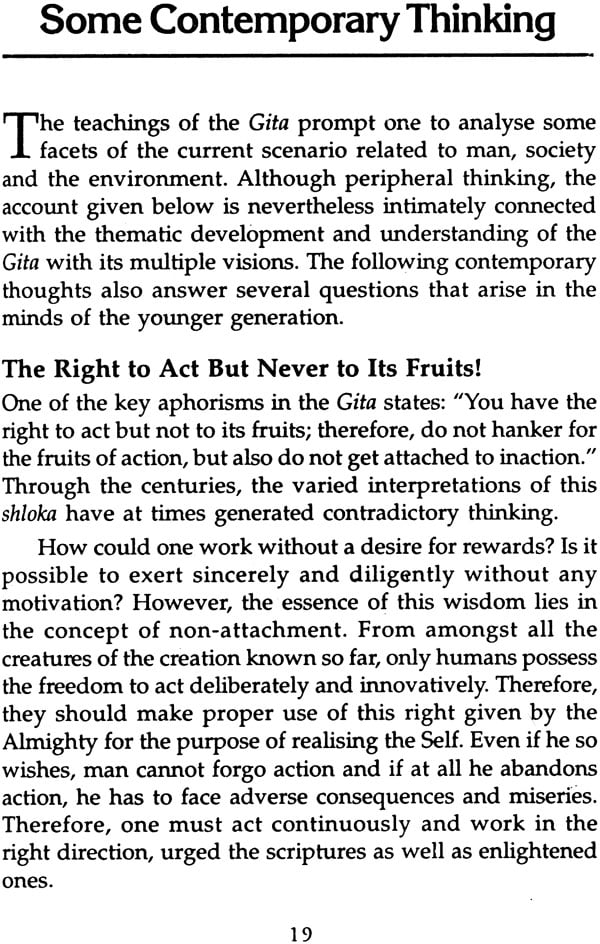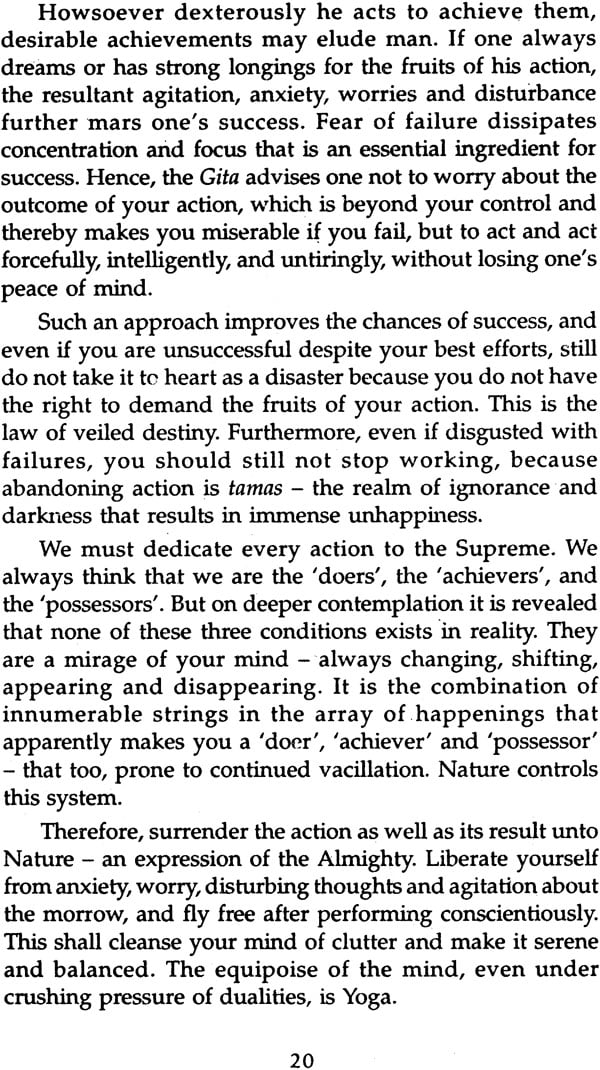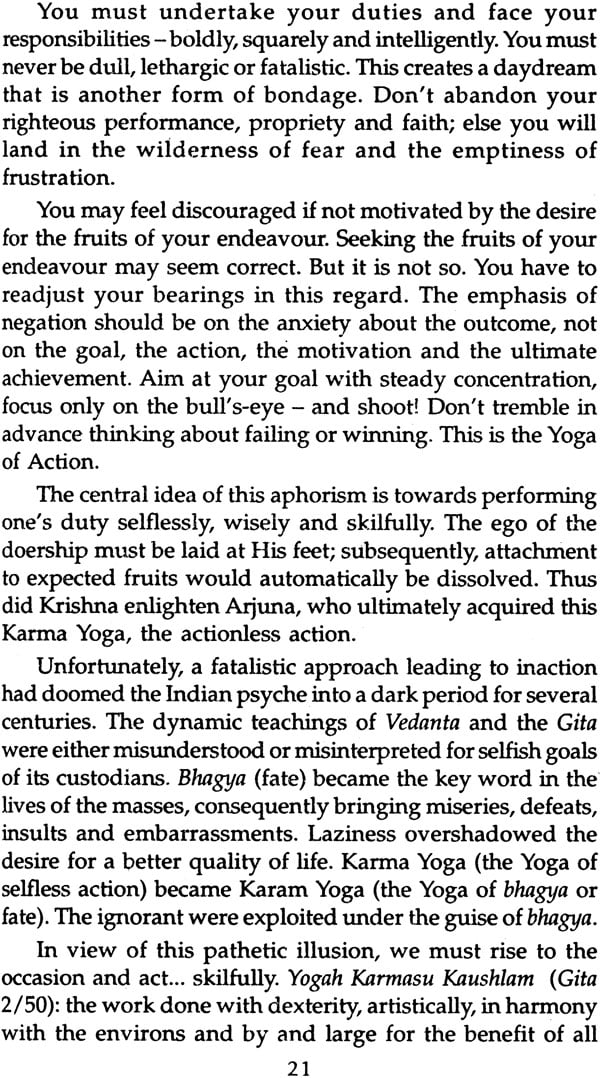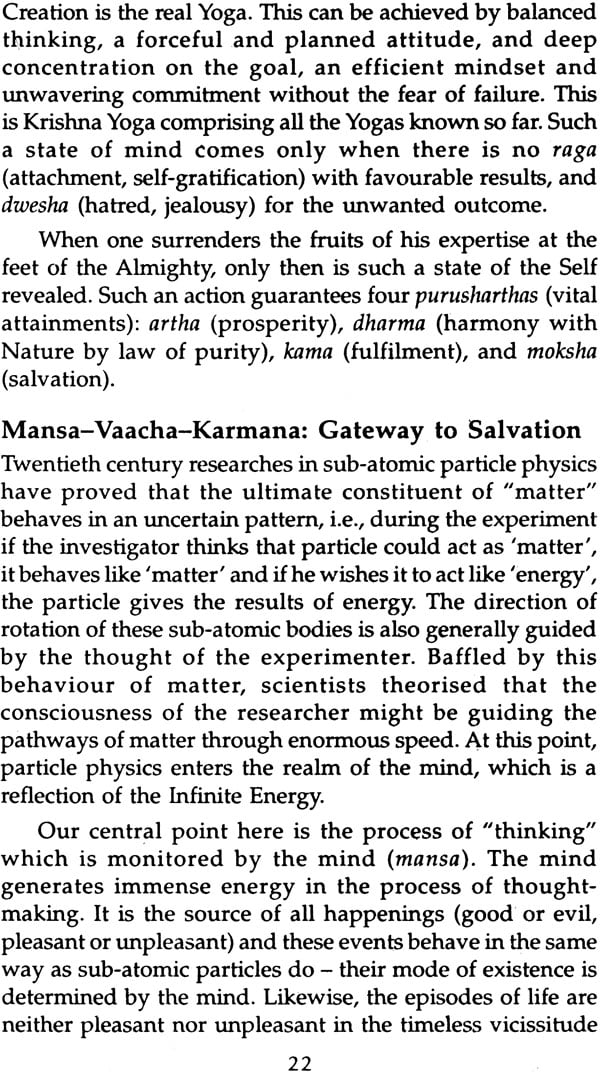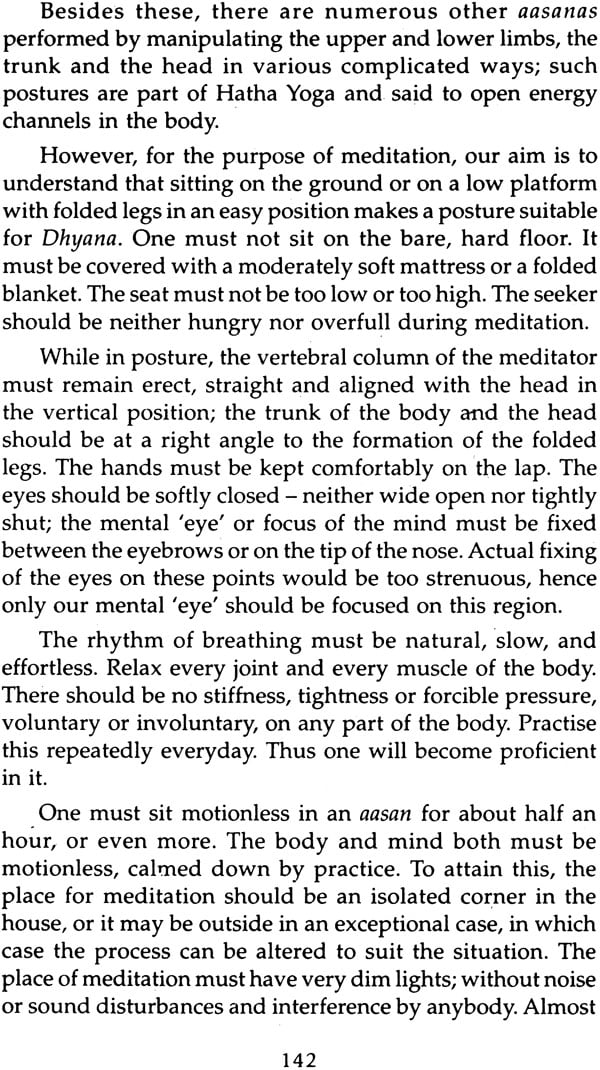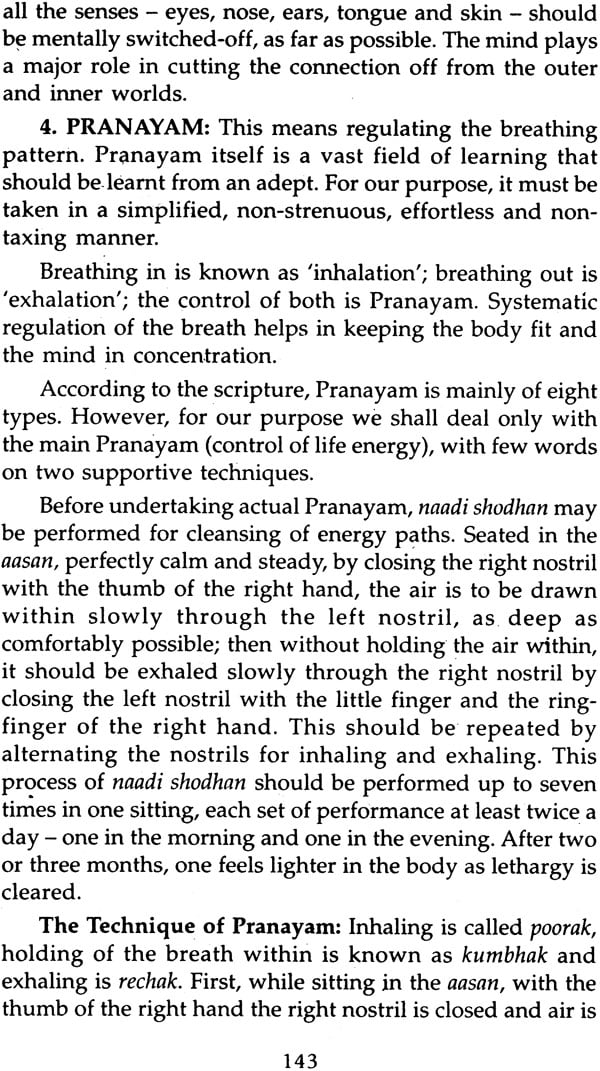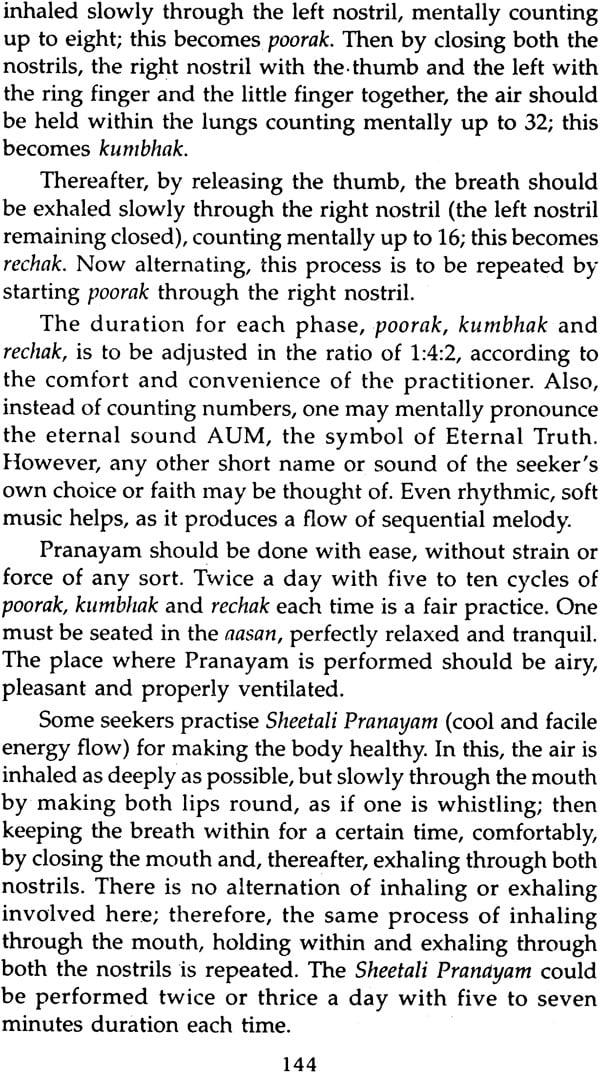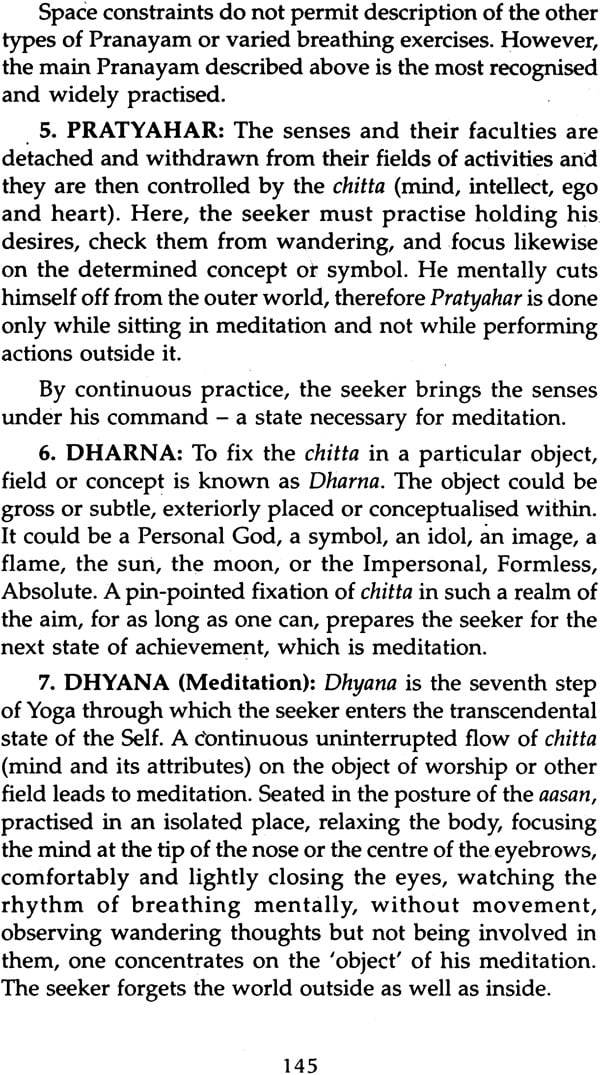
The Yoga of Gita : Scriptural Guidelines to Success, Serenity Harmony and Happiness
Book Specification
| Item Code: | NAE907 |
| Author: | Dr Ram Shanker Tiwari |
| Publisher: | Pustak Mahal |
| Language: | English |
| Edition: | 2003 |
| ISBN: | 9798122308500 |
| Pages: | 160 |
| Cover: | Paperback |
| Other Details | 8.5 inch X 5.5 inch |
| Weight | 210 gm |
Book Description
The Bhagavad Gita is replete with universal wisdom and the techniques to attain this. The Yoga of Gita contains the essence of this wisdom, the philosophy of creation and the Ultimate Reality, as revealed by Sri Krishna to Arjuna. The book outlines the various paths for realization. For the layman, the emphasis is on the Yoga of Action – acting without worrying about the rewards for our actions.
The book is a rendition of the 18 chapters, retold in simple language, with a brief account on Yoga and Meditation, which will ensure success, serenity, harmony and happiness for readers who follow these principles, finally leading to Salvation.
Born on 9 January 1936, Dr Ram Shanker Tiwari, MSc, PhD, FPbS, is an internationally reputed scientist (palaeobotanist). After post-graduation in 1959, he joined the Birbal Sahni Institute of Palaeobotany, Lucknow under DST, New Delhi, and retired as its Director in 1996. Thereafter, the Council of Scientific and Industrial Research awarded him an Emeritus Scientist position for five years.
Dr Tiwari has a deep interest in philosophy, spirituality, human relations and the environment. He has been on the editorial boards of several periodicals and also served as the Chief Editor of two international journals, Geophytology and The Palaeobotanist. He has published around 150 original research papers.
Srimad Bhagavad Gita is a part of Srimad Bhagavad Puran- a Great Epic written in Sanskrit verse by the sage-poet Vyasa. The Puran contains musical lyrics on episodes woven around the Eternal embodiment of Lord Krishna, the splendour of His Life and teachings, besides love and devotion to the Divine, codes for blissful living and the Dharma, i.e., the right way of living. In the Gita, the essence of universal wisdom, the science of human nature, the philosophy of creation, the Ultimate Reality, and the technique to attain that Truth have been narrated by Krishna to his friend and devotee – Arjuna.
This knowledge was imparted in a tense situation, in the centre of the battlefield, just when the Mahabharata war was about to begin between the families of cousin brothers – the Kauravas and the Pandavas. Krishna was the charioteer of one of the Pandava princes, Arjuna, the chief archer, who had no desire to fight his kinsmen for the sake of regaining their kingdom, which was captured by the Kauravas through deceit. Ultimately, the divine light of the Gita dispels the darkness of emotional breakdown in Arjuna. He acts and he wins...
This book is a simple rendition of the main aspects given in the 18 chapters of the Gita. Herein, each chapter is informally divided into two portions: the first half, up to the divider mark, is based on the original concept, abridged from the Gita; and the second half, after the divider mark, includes a simplified interpretative comment by the author. At the end of each chapter, a ten- point Gita Gyan is appended, which again is the author’s attempt to summarise the chapter in a simple way, while incorporating all its essential elements.
A brief account of Yoga and meditation is appended at the end; this may be useful for beginners. Also, to prompt self- search thereafter, the author has added two verses on self- reflection.
In Hinduism, Krishna is adored as an incarnation of Lord Vishnu, the Supreme who sustains Creation. Hence, Krishna has always been addressed as ‘Lord Krishna’, ‘God Krishna’, and ‘Bhagwan Sri Krishna’ in the epics and scriptures. Also, Krishna has been totally established in the Absolute Reality through Eternal Yoga, hence He is to be conceptualized as Supreme with total attributes of the Almighty. He is Yogiraj Krishna – the king of Yoga, Who is One with Pure Consciousness. Throughout the present work, He is referred to simply as ‘Krishna’ – meaning thereby ‘Lord Krishna’; the informality brings simplicity and proximity. Yet, Krishna is addressed as ‘He’ – with a capital ‘H’, a symbolic connotation of His Greatness as Pure Consciousness. While talking to Arjuna, Krishna was One with the Absolute; He speaks in Direct Speech – First Person Singular, e.g., “All this world is pervaded by Me in My unmanifested form”. In the text herein, however, for the sake of facile running of the statements and simplification, an Indirect Speech has been used.
While referring to human beings, the epithets ‘he’, ‘his’, ‘him’, etc, are used, yet they must be taken to include both male and female – again an adoption for plainness and non- repetition. So also, Godheads or even the Absolute, the Almighty are referred to as ‘He’, etc. This does not imply male chauvinism but is suggestive of the fact that the Impersonal God, the Reality, is not limited by any quality of nature, hence not confined by nay character of the body, mind, intellect or ego, etc. Even ‘He’ does not qualify the Supreme, yet we have to use some form of address for our understanding. The Personal God, however, may be conceptualized for visualisation by the human mind with some characterizations, although the qualities – whatever the human mind thinks of God – remain a superimposition as well as an attempt to limit the Limitless!
The subtitle of the book reflects the ultimate aim of our lives. In India and abroad, Hindus and several followers of other faiths know about the Gita. The learned ones and those desirous of learning about all the major religions of the world can tell what contains the Gita. Yet, because of the complexity of content or the detailed commentaries and intricate religio- philosophical implications, much remains for the layperson to comprehend.
This is particularly so with the younger generation, who have the will to learn but little time or patience to venture deeper. Usually, they realise that the Gita advocates ‘work but do not desire its fruits’ and wonder: how is this possible? Or, ‘the Atman is immortal; only it changes the body like worn- out clothes’ and wonder: where do I go after my death?
The new generation also has a lot of interest in Yoga, but in its modern, altered form. Alas! It is the new fashion of life to practice Yoga but nothing much is achieved except some relaxation. Yoga is Divine Knowledge without any religious stigma or bias, through which, if understood properly, one can achieve total happiness and fulfillment in life. The Gita is a treatise on Yoga.
Keeping this aspect in mind, short, simplified basics of the Gita have been compiled in this book. In no way is it a learned commentary, an explanatory series of notes, or an intellectual interpretation – of which I am fully aware. It only puts forth, simply and briefly, the wisdom strewn throughout the Gita. It is neither preaching by the author nor an attempt to change your established beliefs; yet it is an attempt to unfold one’s personality and bring harmony into life along the lines the great Yogiraj Krishna had narrated four millennia ago. If a person follows even a few directives given by Krishna, he can win the battle against adversities and live a prosperous, happy and peaceful life hereafter. If one goes deeper, he can attain freedom and become one with Pure Consciousness.
The antiquity of the Bhagavad Gita dates back to about four thousand years or even more. It is a classic divine song based on the dialogue between Krishna and His warrior friend, Arjuna. In its extensive sense, Yoga is the undercurrent theme of the major realms narrated by Krishna, which shall lead to freedom when practised.
Krishna imparts the Divine Knowledge at a very crucial juncture in the centre of the battlefield just before the Mahabharata war between cousins was about to commence over the division of their kingdom. Lord Krishna is an incarnation of the Supreme, in that He is the Yogiraj (the Greatest of Yogis). He was perfectly in tune with the Cosmic Intelligence through His complete establishment in Eternal Yoga; and Arjuna was a mundane prince, shattered on facing the hard reality of life, which challenged him to annihilate his own elders, teachers, friends, and cousins who were ready to fight against him. Although he had an intense desire for victory, the anxiety of the killing and destruction that would follow – even he himself and his four Pandava brothers could be killed – disoriented and confused him. He could not decide whether to fight or to put down his weapons.
At this threshold of emotional distress and mental agony, he put down his bow and arrows, trembling at the thought of the inevitable death, destruction and devastation on both sides of the family and the resulting trauma for those who survived the war. Arjuna felt that even if he were victorious after killing his cousins-turned-enemies and their supporters, he would accumulate great sins and would never be happy although he and his brothers would win back their kingdom from the Kauravas.
Before the declaration of the Mahabharata war, Krishna had exhausted all possible efforts for a peaceful settlement between the two families. As Krishna was related to both the sides and also believed that peace should not be disturbed at any cost, He acted as a mediator. Regrettably, the Kauravas were adamant and inconsiderate. They were not ready to part with any land at all. Therefore, war remained the only way out to settle the issue.
Before the war, Krishna gave both sides the option of choosing either Him or His army to fight on their side. The Kauravas asked for His army to fight on their side. But the Pandavas requested Krishna Himself to be with them, to which He agreed but purely in a non- combatant’s role. He took the responsibility of being a charioteer for Arjuna during this war for justice. Krishna was Arjuna’s friend, mentor, teacher, guide and philosopher.
Now, as Arjuna stood miserable, indecisive and fearful, Krishna advised him to act and not to worry about the fruits of the action; to witness the episodes of life and death; the cycles of happenings; the ongoing drama of creation, sustenance and dissolution of the universe under the illumination of the Supreme; the ever- changing vicissitude of life in the Cosmic Perspective; and the Immutable, Imperishable Divine Reality. Krishna told him that the only way to overcome his mental agony was to remain poised, unperturbed and calm, abandoning wild desires under all circumstances. And He advised Arjuna to act, and not to react with passion. Such a blissful state of mind could be achieved only through Yoga.
Subsequently, imbibing the teachings of Krishna and ‘beholding’ the Cosmic Form of the Supreme – which is All- pervading, Beginningless, Limitless, and Endless, in which all are heading towards their terminal fate of death under the sway of Time – Arjuna achieved enlightenment. He experienced that action is the method for breaking the bondage of attachment and knowledge is the only way to dispel the darkness of ignorance. It is an attitude towards life as well as the world that must be changed to purify negative tendencies. Pure Consciousness ever illumines all happenings. This could be realised by concentration of the mind and single- pointedness of purpose.
Ultimately, Arjuna gathered his wits, became calm and composed and thereafter fought with valour to emerge victorious.
In much the same manner, our life is a battlefield. In the ongoing battle between good and evil, we may be involved inadvertently and have to struggle every moment. We have to fight at the physical level to protect our body from hunger, disease and the vagaries of nature, as well as from anti- social elements and the machines of modern comfort! Our energy dissipates in gathering comforts and luxuries and in protecting them. Mistakenly, we consider our acquirements to be permanent. Alas, in the ever- changing world, nothing is forever. When our material wealth, power and honour, which we earned with great effort, are lost, we become miserable.
At the mental and intellectual levels, our fight goes on with various confused systems of faiths, ‘isms’, theories, and contradictory ideas about political structures and even science. Such mind – enslaving cults take birth everyday. Yet, we don’t get clear answers to our burning questions – Who am I? For what purpose have I come to this world? What is the ultimate aim of my life? Is it simply to eat, drink and remain in sensuality like a beast, or is it something higher? Where does true happiness lie?
These questions haunt us knowingly or unknowingly, and we go on fighting battles in search of that which we do not know! Actually, we all are in search of ananda, Bliss, which is our real nature, but very few know this fact and simply grope in the darkness for happiness.
At the emotional level, we are most miserable. Even close relationships fall apart and we are disillusioned; friends or colleagues deceive or misunderstand us; children do not meet our expectations and even our spouse may be unfaithful. What a tragedy!
During our journey of life we ride the raging waves of time, caught up in dualities: happiness – unhappiness, profit- loss, health- sickness, honour- dishonour, heat- cold, love- hate, and innumerable others. The Gita teaches one to be balanced and poised even under the influence of contradictory pulls and pressures. But at times, we become desperate like Arjuna! We lose viveka, the discriminative intellect, and the objectivity of a situation because our understanding is veiled by selfish attachment.
Thus, we are consumed in the marathon chase after happiness and we may achieve this for a short while. But we forget that nothing is stable in this world and so we are distressed most of the time, if we do not cultivate the power of objectivity about life’s realities and the play of the Supreme. We are given tremendous opportunities for spiritual evolution by Nature, but if we don’t explore ourselves within, this is our misfortune!
Our wild desires and an ever- wandering mind make us a wreck. The most tragic situation arises when we toil hard at work, hankering for a favourable result under pressure from an agitated mind but we don’t get the desired result. In this vicious cycle, we become victims of our own mind, which is conditioned by our ego. The ego, in reality, is our own Self (soul) but it acquires the qualities of gross Nature and is covered by remnant vaasnas or tendencies of several planes from past time. Thus, the ego accumulates good or evil happenings. As long as the soul (the Pure Self) within us remains covered by the dark smoke of desires, passion, dullness, lust, greed, and anger, and as long as these traits within us are not purified, the Consciousness within us remains hidden. Therefore, it does not shine forth and shower real happiness and genuine fulfillment, which is His Nature.
In such a situation, Krishna’s blissful clairvoyance can come to our rescue. We may remain happy, successful, tranquil and balanced in our life if we practice the essence of the Gita. The testimony of this promise is self-evident throughout human history.
Symbolically, our life is like the battlefield of Mahabharata. Our five major senses and their ramifications are the Pandavas (five brothers). In totality, the body, mind, intellect, chitta and the ego are extensions of our experienced world. We are continuously struggling with the hundred demoniac traits (the Kauravas were one hundred brothers) within and without. The chief warrior, Arjuna, is our mind, in conjuction with the intellect and ego. Lord Krishna is Pure Consciousness – the Cosmic Intelligence Who illumines our mind and intellect only when they are purified and cleansed after we surrender unto Him with a prayer to become the charioteer of our life.
In our distress, rejected by the world, we throw away our bow and arrows and perspire with anxiety about the reward or fruits of our action and remain in the dark about our unknown and uncertain destiny. But just as Arjuna surrendered at the altar of the Almighty, if we lay ourselves at His feet, He saves us and ushers enlightenment into our lives. This leads to freedom or salvation.
Today, the Gita is no more the monopoly of a single religion or culture; it has crossed all barriers erected by man and acquired a universal character. It is a science of humane thoughts, righteous actions, dynamic living, love and peace, a continuous happiness and Realisation of the Truth. It is also an art of success and happiness for those who adopt the teachings into their life without any bias whatsoever. It is a grand treatise of Cosmic Yoga.
The new age most needs the wisdom of the Gita because of eroding value systems, stupendous consumerism, unscrupulous exploitation of Nature resulting in the poisoning of our environment, rocketing passion for sensuality and super-luxury, terror killings in the name of religion, politics or blinkered heroism, and incurable unhappiness in spite of a glut in many aspects of life.
Although better informed and superbly equipped with modern technology, the younger generation is mostly without its bearings in the realm of self- evolution; it is, therefore, to be understood that only knowledge about the Supreme, the Self, the Cosmic Yoga of Krishna, and the value-based living thus achieved, can be helpful in attaining real, stable peace and happiness in all walks of life.
The Yoga as narrated in the Gita by Yogiraj Krishna can bring the Eternal Light into the lives of those who practice it in world and deed.
| Introduction | 13 | |
| Some Contemporary Thinking | 19 | |
| Chapter 1 | The Horror of Life's Problems | 27 |
| Chapter 2 | Knowledge is Pivotal | 31 |
| Chapter 3 | Action is the Method | 36 |
| Chapter 4 | Self- perfection is the Technique | 41 |
| Chapter 5 | Renounce and be Liberated! | 46 |
| Chapter 6 | Meditation: The Quietude of Mind | 50 |
| Chapter 7 | The Insight of Illusion: Gateway to Freedom | 56 |
| Chapter 8 | Get in Touch with the Self: The Eternal Truth | 61 |
| Chapter 9 | The Fire of Awareness | 67 |
| Chapter 10 | Divine Glories Empower Meditation | 72 |
| Chapter 11 | The Infinite Cosmic Pattern | 79 |
| Chapter 12 | Success Through the Yoga of Devotion | 85 |
| Chapter 13 | Fragrance of the Conscious Supreme | 90 |
| Chapter 14 | Inborn Attitudes: Gears of Progress | 97 |
| Chapter 15 | Freedom and Bliss | 103 |
| Chapter 16 | Let Divine Light Radiate! | 109 |
| Chapter 17 | Evolve by Efforts and be Free | 114 |
| Chapter 18 | Fearless, Doubtless, Perfect and Blissful.. You! | 119 |
| Summary | 127 | |
| Appendix I | 131 | |
| Table 1 | 149 | |
| Table 2 | 151 | |
| Appendix II | 153 |
